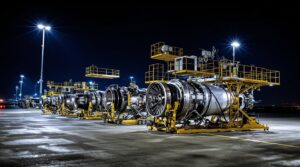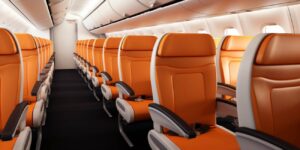At its full capacity, the Airbus A380 can accommodate an impressive 853 passengers in a typical three-class configuration. This configuration typically includes First Class, Business Class, and Economy Class, offering a luxurious and comfortable experience for passengers across the spectrum of travel preferences.
However, airlines have the flexibility to customize the interior layout based on their specific needs and target market. Some airlines opt for a more spacious configuration, prioritizing comfort and exclusivity, resulting in a reduced overall capacity. On the other hand, others may choose a denser layout to cater to higher passenger demand, pushing the limits of the A380‘s capacity.
It’s worth noting that the Airbus A380 has undergone several evolutions since its introduction, with the latest variants featuring even more advanced technology and improved efficiency. These advancements contribute to a more enjoyable flying experience for passengers, emphasizing the aircraft’s role as a symbol of innovation in the aviation industry.
For those curious about the distribution of seats, the typical three-class configuration often includes approximately 14-22 First Class seats, 76-98 Business Class seats, and the majority in Economy Class. The spaciousness of the aircraft allows for a comfortable arrangement of seats, ensuring a pleasant journey for all passengers on board.
Seats and cabin layout in the airbus a380
The Airbus A380, the world’s largest passenger airliner, boasts an innovative cabin layout designed for optimal comfort and efficiency. The spacious interior of the A380 is configured in a two-deck layout, with the main deck typically hosting economy class and premium economy, while the upper deck is reserved for business and first-class passengers.
The main deck features a 3-4-3 seat arrangement in the economy class, providing a balance between capacity and passenger comfort. This configuration allows for a total of approximately 555 passengers on the main deck. Premium economy is usually arranged in a 2-4-2 layout, offering a more generous seat pitch and enhanced amenities for passengers seeking an elevated experience.
Ascending to the upper deck, passengers are greeted with a more exclusive atmosphere. The business class on the A380 typically adopts a 2-2-2 or 1-2-1 seat configuration, ensuring direct aisle access for every passenger. This design prioritizes privacy and convenience, providing a conducive environment for work or relaxation during the flight.
At the pinnacle of luxury, the first-class cabin on the A380 features a 1-2-1 seat configuration, providing each passenger with a fully enclosed suite and direct aisle access. This layout not only enhances privacy but also offers an unparalleled level of comfort, with seats that can be converted into full-flat beds.
For those seeking an extra touch of extravagance, some airlines have introduced private suites within the first-class cabin. These suites come with closing doors, personal entertainment systems, and dedicated crew service, creating an oasis of tranquility at 30,000 feet.
Understanding the importance of ergonomics, Airbus has designed the A380’s seats with a focus on passenger well-being. The seats are equipped with adjustable headrests, ample legroom, and in-seat entertainment systems. Additionally, the large windows on the A380 provide passengers with stunning panoramic views, contributing to an overall enhanced flying experience.
In terms of special accommodations, the A380 is also equipped to cater to passengers with reduced mobility. Airlines can customize the cabin layout to include designated spaces for passengers with disabilities, ensuring that air travel remains accessible to everyone.
Comfortable seats and passenger space in giant airbus
The Airbus A380, renowned for its colossal size and grandeur, stands as a paragon of luxury in the aviation realm. Its interior configuration is a testament to meticulous design and a commitment to passenger comfort. Stepping into the spacious cabin, one is immediately struck by the comfortable seats strategically arranged to optimize every inch of available space.
The seating layout on the Airbus A380 is ingeniously crafted to accommodate a staggering number of passengers without compromising on personal space. With multiple classes available, including first class, business class, premium economy, and economy, the aircraft caters to diverse traveler preferences. Each class boasts its own unique charm, but common across all is the emphasis on passenger space and ergonomic design.
Let’s delve into the specifics. In the first class cabins, passengers are treated to opulent, wide seats that can often be converted into fully flat beds, ensuring a restful journey. The business class section follows suit with generously sized seats, offering a perfect balance between work and relaxation. Premium economy introduces an intermediate level of luxury, providing more space and enhanced amenities compared to standard economy.
For those in standard economy class, fear not, as Airbus has not overlooked your comfort. The seating arrangement is thoughtfully designed to optimize legroom and overall passenger space, making long-haul flights a more bearable experience. With carefully positioned windows and overhead compartments, even the economy class exudes a sense of spaciousness.
As passengers revel in the comfort of their seats, the Airbus A380 doesn’t skimp on storage either. Ample overhead compartments are available for carry-on luggage, ensuring that every traveler has convenient access to their belongings throughout the flight. Additionally, the aircraft is equipped with baggage handling systems that efficiently manage checked luggage, streamlining the boarding and disembarking processes.
While statistics vary depending on the airline’s specific interior configuration, a typical Airbus A380 can accommodate anywhere from 500 to over 800 passengers. The number of passengers is a staggering figure, but thanks to the thoughtful interior design, each individual can enjoy a sense of personal space, making the journey a delightful experience.
Number of crew required to operate an airbus a380 flight
The Airbus A380 is a marvel of modern aviation, known for its colossal size and impressive capabilities. When it comes to operating this giant in the skies, the number of crew required is a critical factor. Piloting the A380 demands a skilled team, typically consisting of two pilots and a complement of cabin crew members, the exact number varying based on airline policies and specific flight requirements.
Now, let’s delve into the heart of this airborne giant’s specifications. The takeoff weight of the Airbus A380 is a staggering feat in engineering. This mammoth aircraft can reach a takeoff weight of over 1.2 million pounds, showcasing its immense strength and structural integrity. This weight includes not only the aircraft itself but also the combined load of passengers, cargo, and fuel.
Speaking of payload, the A380 is designed to carry an extensive load across its two full-length passenger decks. With a maximum seating capacity of around 853 passengers in a typical two-class configuration, the A380 can efficiently transport a large number of people. Additionally, the cavernous cargo hold allows for the transportation of substantial freight, further enhancing its versatility.
Now, let’s turn our attention to the crucial aspect of fuel capacity. The A380 boasts an impressive fuel capacity, with its tanks capable of holding approximately 81,890 U.S. gallons (310,000 liters) of aviation fuel. This extensive fuel storage enables the A380 to cover vast distances, making it an ideal choice for long-haul flights where efficiency and endurance are paramount.
The powerhouse behind the A380’s extraordinary performance lies in its number of engines. This colossal aircraft is equipped with four powerful turbofan engines, specifically the Rolls-Royce Trent 900 or Engine Alliance GP7200. These engines provide the necessary thrust to propel the A380 through the skies, allowing it to reach cruising altitudes and speeds that define modern air travel.






